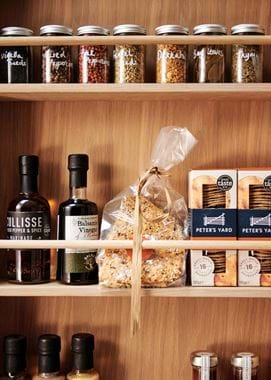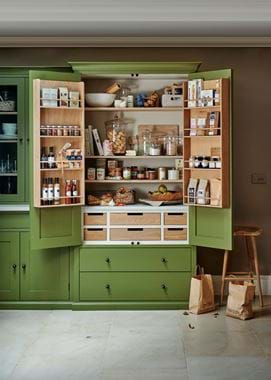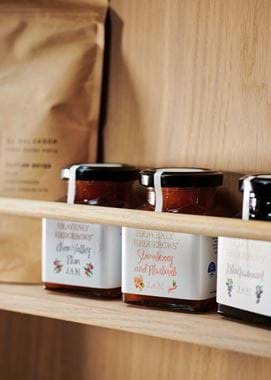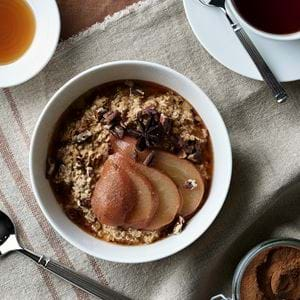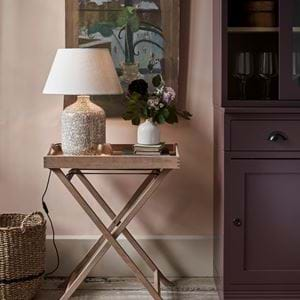In the larder: our spring staples
In the larder: our spring staples
A well-stocked larder is the secret to kitchen calmness. When a delicious and nutritious meal can always be rustled up from just a few fresh ingredients and the staples that fill your shelves, the words ‘there’s nothing to eat’ become a thing of the past.
We like to revisit what’s in our larders seasonally, making the arrival of spring and autumn a time to refresh, donating what’s never used (spices bought on a whim, we’re looking at you) and introducing ingredients and flavours that are perfect for the months to come. To inspire you to do the same, Georgie, the nutritional therapist from our café, The Provenist, is here sharing her kitchen cupboard must-haves for year-round and for the warmer and brighter weeks just ahead.
For all year long
This isn’t quite an exhaustive list, but it’s a good place to start.
- quinoa and pearl barley (for warm salad bowls)
- lentils (green ones take a little while to cook but keep their texture and shape well)
- wild rice (lower in calories and higher in protein than brown rice)
- oats (rolled, jumbo oats are best for porridge)
- buckwheat flour (this lends a nutty depth of flavour to pancakes, and is naturally gluten-free)
- maple syrup (more flavourful than sugar, maple syrup also has a lower glycaemic index, so it won’t cause spikes in your blood sugar levels)
- local honey (another natural, low-GI sweetener that’s also actually especially good to have around in summer if you suffer with hayfever as it can help build up your tolerance to local pollen)
- nut butter (add to pancakes and porridge for a protein, antioxidant and good-fat boost. As with all nut products, it’s important to choose a butter that’s sourced sustainably and doesn’t contain palm oil)
- mixed seeds (sprinkle these over soups, porridge, salads and smoothie bowls)
- chilli flakes (essential for smashed avocado or poached eggs on toast)
- beans (butter beans or cannellini, dried or in tins, for making posh beans on toast)
- soy sauce and miso paste (both for adding that essential umami flavour)
- dried herbs (these are better in dishes that need a long, slow cook than fresh herbs which would lose their potency. Bay and thyme dry particularly well)
- coconut oil (for baking)
And, of course:
- olive oil (normal, for cooking and extra-virgin for serving) or organic rapeseed oil if you’d prefer to stay local
- salt (you can get all sorts of salts for different purposes, but if you only buy one, I’d make it sea salt flakes, which are delicate enough for finishing and melt well into sauces. Try a British brand like the Cornish Sea Salt Co. or Halen Môn from Anglesey)
- pepper (whole peppercorns that you can grind fresh. We use mixed colours for a more complex flavour)
For spring and summer
Now’s the time to think ahead to the kind of dishes you’ll be making over the next six months – from lighter, fresher soups and tarts to Mediterranean and Middle Eastern-inspired meals – and add to your larder with the spices, seasonings and sauces you’ll need to create them.
For sprinkling and seasoning:
- fennel seeds (an essential if you’re grilling fish on the barbecue)
- coriander seeds (these have a citrusy-minty flavour that’s perfect for summer)
- dukkah and za’atar (both of these Middle Eastern spice and herb blends are great for adding flavour to all sorts of dishes, including simple bread and olive oil. We’ll be sprinkling dukkah onto minted peas on toast at The Provenist this spring)
- pink peppercorns (lighter in taste than black peppercorns, try these ground into summer sauces and rubs)
- pickling spices (I like to keep Steenbergs’ blend on hand for making fresh and crunchy pickles out of spring and summer vegetables)
- infused oils (you can use these all year round, but their flavour will be most noticeable in simpler, fresher summer dishes. Try making your own with olive oil and garlic, rosemary or fresh chillies)
Tins, packets and jars:
- capers (these tiny, salty flower buds are a key ingredient in lots of Italian dishes. We’ll also be using them in a salsa for our beetroot and feta fritters at The Provenist this season)
- chickpeas (useful all year round, but falafel and hummus always feel like especially summery dishes to me)
- pesto (fresh is best, but a good jar of pesto is worth having in the cupboard for when you’re in a pinch. Always try for organic, and if you find that basil pesto is too strong, try one made from cavolo nero or spinach)
- pine nuts (for making that fresh pesto. Choose responsibly sourced pine nuts or substitute them with British-grown walnuts instead)
For your ‘second larder’:
A.k.a. your freezer. Make the most of it this season to capture fresh produce at its very best (such as raspberries and peas that quickly lose their nutrients and texture) and preserve anything you have too much of to use now. We always save fruit – such as chopped-up, tender, pink stems of forced rhubarb in early spring and berries and currants come summer – in ours to use in compotes. And you can also chop up fresh herbs like chives and freeze them in oil in ice cube trays. Just take them out shortly before you serve and add to warm salad bowls and soups.
If you’re ever in Bath, be sure to pop by and see us at The Provenist.


